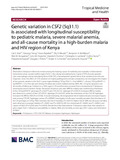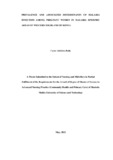Genetic variation in CSF2 (5q31.1) is associated with longitudinal susceptibility to pediatric malaria, severe malarial anemia, and all-cause mortality in a high-burden malaria and HIV region of Kenya
Date
2022-06-25Author
Kisia, Lily E.
Cheng, Qiuying
Raballah, Evans
Munde, Elly O.
McMahon, Benjamin H.
Hengartner, Nick W.
Ong’echa, John M.
Chelimo, Kiprotich
Lambert, Christophe G.
Ouma, Collins
Kempaiah, Prakasha
Perkins, Douglas J.
Schneider, Kristan A.
Anyona, Samuel B.
Metadata
Show full item recordAbstract
Plasmodium falciparum infections remain among the leading causes of morbidity and mortality in holoendemic transmission areas. Located within region 5q31.1, the colony-stimulating factor 2 gene (CSF2) encodes granulocyte–macrophage colony-stimulating factor (GM-CSF), a hematopoietic growth factor that mediates host immune responses. Since the effect of CSF2 variation on malaria pathogenesis remains unreported, we investigated the impact of two genetic variants in the 5q31.1 gene region flanking CSF2:g-7032 G > A (rs168681:G > A) and CSF2:g.64544T > C (rs246835:T > C) on the rate and timing of malaria and severe malarial anemia (SMA, Hb < 5.0 g/dL) episodes over 36 months of follow-up. Children (n = 1654, aged 2–70 months) were recruited from a holoendemic P. falciparum transmission area of western Kenya. Decreased incidence rate ratio (IRR) for malaria was conferred by inheritance of the CSF2:g.64544 TC genotype (P = 0.0277) and CSF2 AC/GC diplotype (P = 0.0015). Increased IRR for malaria was observed in carriers of the CSF2 AT/GC diplotype (P = 0.0237), while the inheritance of the CSF2 AT haplotype increased the IRR for SMA (P = 0.0166). A model estimating the longitudinal risk of malaria showed decreased hazard rates among CSF2 AC haplotype carriers (P = 0.0045). Investigation of all-cause mortality revealed that inheritance of the GA genotype at CSF2:g-7032 increased the risk of mortality (P = 0.0315). Higher risk of SMA and all-cause mortality were observed in younger children (P < 0.0001 and P = 0.0015), HIV-1(+) individuals (P < 0.0001 and P < 0.0001), and carriers of HbSS (P = 0.0342 and P = 0.0019). Results from this holoendemic P. falciparum area show that variation in gene region 5q31.1 influences susceptibility to malaria, SMA, and mortality, as does age, HIV-1 status, and inheritance of HbSS.
URI
https://doi.org/10.1186/s41182-022-00432-5https://tropmedhealth.biomedcentral.com/articles/10.1186/s41182-022-00432-5
http://ir-library.mmust.ac.ke:8080/xmlui/handle/123456789/2420
Collections
- Gold Collection [1026]
Related items
Showing items related by title, author, creator and subject.
-
PREVALENCE AND ASSOCIATED DETERMINANTS OF MALARIA INFECTION AMONG PREGNANT WOMEN IN MALARIA EPIDEMIC AREAS OF WESTERN HIGHLAND OF KENYA.
Ashivira, Cyrus Bally (MMUST, 2021-05-11)Globally malaria in pregnancy continues to cause important public health concern for health care sector. Apparently, the disease remains to be a major determinant of maternal morbidity and mortality. In Kenya malaria ... -
PREVALENCE AND ASSOCIATED DETERMINANTS OF MALARIA INFECTION AMONG PREGNANT WOMEN IN MALARIA EPIDEMIC AREAS OF WESTERN HIGHLAND OF KENYA
Bally, Cyrus Ashivira; Arudo, John; Kipmerewo, Mary (Global Journal of Health Sciences, 2020-08-13)Purpose: To determine prevalence and associated determinants of malaria infection among pregnant women in Western highland of Kenya, and specifically, Mt. Elgon Sub-County. Methodology: Cross-sectional analytical design ... -
PREVALENCE AND ASSOCIATED DETERMINANTS OF MALARIA INFECTION AMONG PREGNANT WOMEN IN MALARIA EPIDEMIC AREAS OF WESTERN HIGHLAND OF KENYA
BALLY, ASHIVIRA CYRUS (MMUST, 2021-05)



